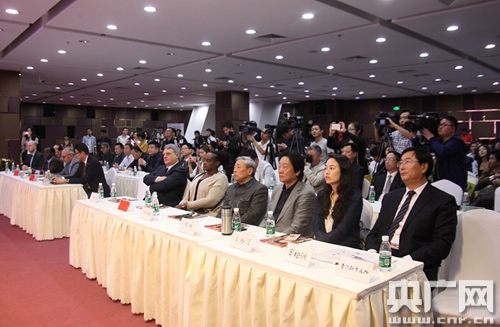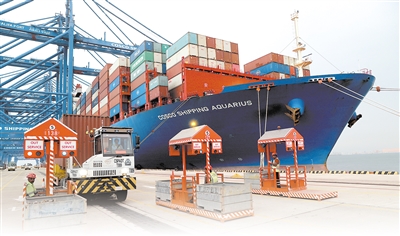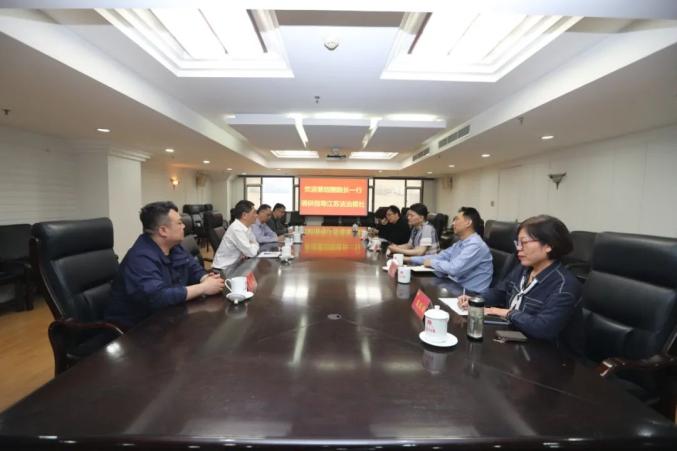Strengthen International Cooperation In Outer Space And Realize The Vision Of A Community With A Shared Future (authoritative Forum)
Strengthen International Cooperation In Outer Space And Realize The Vision Of A Community With A Shared Future (authoritative Forum)
On June 19, Yang Liwei (left), director of the China Manned Space Engineering Office, and Simoneta Dipipo, director of the United Nations Office for Outer Space Affairs, signed a supplementary agreement on cooperation between China's space stations in Vienna.

On June 19, Yang Liwei (left), director of the China Manned Space Engineering Office, and Simoneta Dipipo, director of the United Nations Office for Outer Space Affairs, signed a supplementary agreement on cooperation between China's space stations in Vienna.
Posted by Xinhua News Agency

Side image of the cruiser taken by the Chang'e-3 probe's topography camera.
Posted by Xinhua News Agency

A Cameroonian friend watched the virtual reality demonstration of the China Space Station at the booth set up by the China Manned Space Engineering Office.
Photo by Zhang Jie

On February 12, China successfully launched the 28th and 29 Beidou navigation satellites at the Xichang Satellite Launch Center.
Posted by Xinhua News Agency
Peaceful use of space and exploring the vast universe is the common dream of all mankind. The high-level meeting commemorating the 50th anniversary of the United Nations Conference on the Exploration and Peaceful Uses of Outer Space recently adopted an outcome document, which included it in China's proposal, calling for "strengthening international cooperation in the field of peaceful use of outer space to realize the vision of a community with a shared future and seek the welfare and interests of all mankind." China's concept of a community with a shared future in outer space has received widespread support from the participating countries
Discuss the future of global space cooperation
This newspaper's special correspondent to Austria Feng Xuejun
Space exploration is a common cause of mankind
This year coincides with the 50th anniversary of the world's joint exploration and peaceful use of outer space. From 19 to 21 June, commemoration of the 50th anniversary of the United Nations Outer Space Conference was grandly held at the headquarters of the United Nations Commission on the Peaceful Uses of Outer Space (United Nations Outer Space Commission) in Vienna. Representatives from various governments, scientific research institutions and business circles gathered to review the achievements of outer space exploration over the past 50 years and explore the future trends of global space cooperation.
Simonetta Dipipo, director of the United Nations Office for Outer Space Affairs, said that space technology has become an important pillar of the 21st century. Space technology plays an important role in promoting these important global development goals, including the United Nations 2030 Agenda for Sustainable Development, the Paris Climate Change Agreement and the Sendai Disaster Reduction Framework. “We should use space technology to improve lives around the world and protect the planet.”
Austrian Foreign Minister Kneisl pointed out that in the context of increasingly diverse subjects of outer space activities and increasing challenges in outer space, all countries should jointly plan the future development order of outer space under the framework of the United Nations, especially clarify the role and development direction of the Outer Space Commission, explore the outer space issues that affect the long-term development of mankind, and strengthen the contribution of outer space activities and outer space technology to the realization of the global sustainable development goals and global governance.
"If you turn your eyes to space, you will be deeply shocked by its vastness and infinity. Space exploration is about everyone around us and is the common cause of mankind." European Space Agency's Italian astronaut Nespoli told our reporter that in the future, all countries should integrate their respective resources, technology and wisdom, and develop and utilize space through cooperation. "For us, there are too many unknown things. If people just drive into space with their own strength, they will not go too far."
The concept of a community with a shared future in outer space has been widely supported
On June 21, the high-level meeting commemorating the 50th anniversary of the United Nations Conference on Exploring and Peaceful Uses of Outer Space adopted the outcome document, which was included in China's proposal, calling for "strengthening international cooperation in the field of peaceful use of outer space to realize the vision of a community with a shared future and seeking the welfare and interests of all mankind." China's concept of a community with a shared future in outer space has received widespread support from the countries participating in the meeting.
Akhyesa, the representative of the Group of 77 and Iraqi Science and Technology Minister, said that realizing the vision of a community with a shared future in the field of peaceful use of outer space should be the primary goal of the next step of action.
Ambassador Shi Zhongjun, China's representative to the United Nations and other international organizations in Vienna, said that the vision of a community with a shared future in outer space reflects the universal demands of the international community and points out the direction for strengthening global governance and international cooperation in outer space and responding to various challenges in the peaceful use of outer space in the new era. China will be committed to promoting common development through cooperation. Outer space is a new territory that enhances the welfare of all mankind. "We must work together to use outer space to promote sustainable development and make the 'cake' bigger. At the same time, we must divide the 'cake' well and narrow the 'outer space gap through cooperation, so that more countries, especially developing countries, can benefit."
Looking forward to working with China to explore outer space
Since the launch of the first artificial satellite in 1957, humans' pace of exploration of space has never stopped. Many ideas that previously existed in science fiction have become reality. In the Round Hall of Vienna International Center, more than 40 exhibitors jointly launched a commemorative exhibition to showcase the latest achievements of global aerospace and the most cutting-edge technology. The "Batolomeo" commercial platform, the "Ice Cube" program, the "Cube Satellite" program... From the global positioning system to the satellite phone number to friends from afar, the application of space technology has made human life more convenient and the world more closely connected. Space technology can also help track endangered species and protect them from poachers, providing agriculture with important data references to increase crop yields, allowing humanitarian rescuers to launch rescue operations worldwide.
The Chinese space station model exhibited by the China Manned Space Engineering Office has attracted the attention of representatives of many developing countries. The China Space Station includes one core compartment and two experimental compartments, and reserves new cabin interfaces to expand the compartment space, supports large-scale external experiments, and is scheduled to be completed and put into use in 2022, with a design life of 10 years. At the end of May, China and the United Nations have officially issued invitations to the world to open to all UN member states, especially developing countries. Public and private institutions committed to scientific development, including research institutes, universities, private enterprises, etc. can also apply.
"Under space is not just an activity venue for developed countries, nor is it a cold technology far away from daily life." Fitzwa Mayora, deputy director of the Space Systems Office of the Ministry of Science and Technology of South Africa, said that the development of the aerospace industry requires a large amount of infrastructure construction, which can promote economic development and drive employment. "After years of its own efforts, China has been among the forefront of outer space exploration. We are very looking forward to jointly exploring outer space under the framework of cooperation advocated by China in the future and improving the aerospace technology level in South Africa and more other developing countries."
China's aerospace cooperation benefits countries in the Belt and Road
The theme promotion meeting on "China's Aerospace Cooperation: Building a Community of Shared Future and Benefiting All Mankind" was held during the 50th anniversary of the United Nations Outer Space Conference, showing China's achievements and international cooperation in major areas such as manned space flight, deep space exploration, Beidou navigation, and space capacity building. At the meeting, China and the United Nations Office for Outer Space Affairs signed a declaration of intention on cooperation in the "Belt and Road" space information corridor and a supplementary agreement on cooperation between China's space stations, donating the Chinese space station model and the Beidou-3 navigation satellite model to the United Nations.
According to Tian Yulong, Secretary-General of the China National Space Administration, the China National Space Administration launched the construction of the "Belt and Road" space information corridor in 2015. Taking China's in orbit and planned and constructed communication satellites, navigation satellites and remote sensing satellite resources as the main body, strengthen cooperation with relevant international satellite systems, provide space information services to countries and regions related to the "Belt and Road" to achieve information interconnection, and benefit the economic and social development of countries in the "Belt and Road".
At present, China has established cooperation mechanisms in the field of satellite navigation with many countries and regions related to the "Belt and Road" and will jointly build the "Belt and Road" space information corridor. On June 5, China successfully launched the Storm 2 H. The satellite will be located at 79 degrees east longitude and can effectively cover most European, Asian and African countries to provide them with meteorological satellite data services.
Write a new chapter in human space cooperation
Yang Yuguang
China's aerospace technology has gone through more than half a century of development, formed a large-scale aerospace industry, and is moving towards a powerful aerospace power. Manned space flight, deep space exploration, ground remote sensing, satellite communications and navigation... China has achieved remarkable achievements. Innovation achievements in various technical fields of aerospace are increasing, and system-level original technologies, as an important symbol of aerospace power, are emerging in major projects and projects such as the space station project, the Beidou navigation satellite project, and the Chang'e lunar exploration and Mars exploration plan. In this process, China has always regarded the peaceful use of space and win-win cooperation as the development concept in the field of space.
In the field of manned space flight, although China's future space station is only half the size of the Mir space station, the progress of the times gives us the opportunity to adopt more advanced technologies, significantly improve in terms of usage efficiency and mission completion, and can be comparable to the International Space Station in many aspects. The scale of the space station is moderately in line with China's national conditions and characteristics as a developing country, and its scalable capabilities have also left broad space for future development.
China's manned spacecraft has faced the world with an open attitude from the beginning. From the Sino-Germany joint life science test carried by the Shenzhou-8 spacecraft to the International Astronautics Federation flag brought back by Shenzhou-9, while China's manned spacecraft has achieved remarkable achievements, it has also continuously deepened exchanges and cooperation with countries around the world, including space powers and developing countries. China announced that the future permanent space station is not only a national-level space laboratory, but also an important platform for cooperation with countries around the world in the field of manned space flight.
Since the announcement of the space station plan, China Aerospace has planned four levels of cooperation: joint tests, crew visits, foreign spacecraft visits and joint cabin sections. Based on the basic configuration of the three-cabin of China's space station, by launching a new core module to dock with the original space station, two more large test cabins can be added, which provides the possibility for future segment-level cooperation with other countries. This feat will write a new chapter in the field of human space cooperation.
Carrying international cooperation in grand projects such as manned moon landing is the consensus of the world's major aerospace powers. Traditional aerospace powers, including Russia and major member states of the ESA, have expressed their willingness to carry out in-depth cooperation in this field. It can be foreseen that the future China manned lunar landing project will achieve higher-level international cooperation goals than today's space station project.
China is also continuously implementing various international cooperation projects in the fields of space science, lunar exploration and deep space exploration. From the early "Double Star" project for scientific research on space environment, to the scientific exploration payloads of European and other regions carried on Chang'e-4, and the huge project of "orbiting and patrol" in the future of China's Mars exploration, all reflect the purpose of advocating international cooperation and the goal of benefiting all mankind. The overseas measurement and control facilities necessary for deep space exploration also reflect the support of other countries for China's aerospace.
China has always regarded aerospace technology that directly serves the national economy as its development focus. International aerospace cooperation in this field also started very early. The China-Pakistan joint resource satellite in the 1990s is known as a model of South-South cooperation. Various remote sensing satellites represented by wind and cloud meteorological satellites have been able to provide many countries with important ground observation data resources. Launching commercial communication satellites for other countries and cooperation in communication satellite payloads has long been a mature commercial activity. In the field of satellite navigation, as one of the few countries in the world that can independently develop satellite navigation systems, the Beidou-2 regional navigation system has become increasingly mature and provides precise positioning and timing services to the Asia-Pacific region and some countries related to the "Belt and Road". The Beidou-3 system, which is under construction and can cover the world, will provide users around the world with a better navigation service experience, and its completion and wide application will also become an important symbol of China's move towards a space power.
Space technology, which has been developed for more than half a century, has become an important driving force for promoting the development of human civilization and social progress, and is an important guarantee for the bright future of mankind. As the world's largest developing country, it is particularly important for China to promote international cooperation in the field of space. Peaceful exploration, development and utilization of space will surely make aerospace exploration and aerospace scientific and technological achievements contributing to the creation of a better future for mankind.
(The author is the Secretary-General of the Space Transport Committee of the International Astronautics Federation and a Researcher at China Aerospace Science and Technology Corporation)
Layout design: Cai Huawei
"People's Daily" (23rd edition, July 4, 2018)





